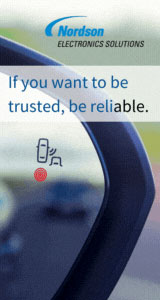|

|
|
| Ask the Experts | |||||||
|
|||||||
|
June 14, 2018 - Updated August 2, 2010 - Originally Posted BGA Component Moisture ExposureWe mistakenly assembled circuit boards using BGA components that were not properly stored. The BGA components had moisture tags that show indication of moisture exposure. All the assemblies passed testing. Can we now rebake the assemblies to ensure we will not have moisture related failures on these devices? Should we remove and replace the suspect BGA components? M. M. |
|||||||
| Expert Panel Responses | |||||||
|
Any damage that mighthave been done by processing expired MSDs cannot be reversed by bakingthe assemblies. And the fact that the assemblies passed in circuit andfunctional testing is not proof that there was no damage duringreflow. One of the most critical facts to understand about the dangersof improperly managing Moisture Sensitive Devices is that themicro-cracking and related defects are difficult to detect. They arefrequently on the underside of the components and typicallymanifest themselves in the form of field failures two to six monthsafter the fact. There is no substitute for a comprehensive MSDmanagement process just as there is no substitute for a comprehensiveESD management process. And lead free processing raises the risk ofnot having procedures in place even higher.
Director Protean Marketing Now a director at Protean Marketing, Mr. Heimsch has worked in the electronics industry 25+ years in a wide variety of international sales, marketing and operations roles. Rich spearheads Protean's international business development, specializing in Brand Management and Strategic Communications.
Instead of using heat (a known enemy of electronics) in an attempt to drive off moisture, it may be more advantageous to use a vacuum chamber in order to actively evaporate any residual water. Heating can put undesirable thermal stresses on electronic devices, which can lead to premature failure. Try using a batch-type plasma cleaning system or other type of vacuum chamber, and pump the chamber down into the several-hundred mTorr range for 15 to 20 minutes (without engaging any plasma or heating, of course.) We find this is usually sufficient to remove residual moisture from electronic components. Anecdotal of course, but we've had success this way recovering cell phones that have been accidentally dropped into water. The key is to immediately remove the battery from the phone in order to ensure there are no short circuits before the water can be thoroughly removed via this vacuum process. Whether or not you'll see short- or long-term failures in your components due to moisture exposure depends on many factors: Did any shorts occur while the moisture was actually present? Did the moisture deposit any contaminants (such as salts or acids) that can subsequently cause shorts, corrosion, or delamination? Did the moisture induce any other modes of failure into the component? A bit of a disclaimer: For mission-critical electronics, such as those used in medical devices, military electronics, or avionics, the safest action is always to replace components which are known to have been exposed to moisture.
Global Marketing Manager Nordson MARCH Mr. Szymanski works to expand strategic alliances, strengthen partnerships with equipment suppliers, and develop future product offerings tailored to the semiconductor market.
NOTE: Mr. Szymanski is no longer working at Nordson MARCH If the components surpassed allowable moisture exposure limitsprior to reflow, which sounds likely, then they may have incurred internal damageduring reflow. Typical moisture-induced defects include micro-crackingor delamination inside the component body, due to excessive pressure exerted byabsorbed water molecules during reflow. There is usually noexternal evidence that can be detected through visual inspection, X-ray orother standard inspection techniques. Such defects are often latent;in other words not severe enough to cause immediate failure. This would explainwhy the units passed initial testing. However, out in the field and overtime a small crack can propagate into a larger one, suddenly and unexpectedly (thinkcrack in your car's windshield), resulting in intermittent performance issues,early life failure, or diminished long term reliability. Re-bakingthe assemblies now will not "undo" any damage that occurred duringthe initial reflow process. Your safest bet is to replace these components withones that were stored and monitored properly prior to reflow. If they areexpensive then an alternative would be to send them to a lab for acousticmicroscopy. An acoustic microscope is the only non-destructive way tocheck inside the component body for cracks and delaminations. Such ananalysis would confirm for sure whether the components need to be replaced.
Sales Manager (Americas) Cogiscan, Inc. Mitch DeCaire, Sales Manager at Cogiscan, has served the electronics manufacturing industry since 1989. His prior experiences include process engineering, business development, and engineering management roles with Nortel Networks, Vansco Electronics, Universal Instruments and Siemens.
When overexposed Moisture-sensitive components go through the solder reflow cycle, the entrapped moisture will turn into steam which can cause internal cracks and delaminations. These internal defects will not necessarily cause an immediate component failure but they can affect their reliability. Rebaking these assemblies will not fix the problem. To evaluate the risk you could perform some reliability tests on the affected units. The simplest solution is to remove and replace the suspect BGA components with dry ones. For more information on this topic I invite you to consult the MSD Knowledge base on our web site.
VP Sales & Marketing Cogiscan Mr. Monette is one of the co-founders of Cogiscan and leads global sales, business development and marketing. Since 1990, he has held a variety of positions in the electronics manufacturing industry, mostly focused on quality and process engineering.
Baking the assemblies willnot fix the parts if they got damaged during reflow. Passing test is not aseparation criteria for bad boards from the good boards. Changing the componentswill involve the usual risk of scrap during rework but do it if the componentsare suspect and the final product functionality is critical.
Engineering and Operations Management Independent Consultant Georgian Simion is an independent consultant with 20+ years in electronics manufacturing engineering and operations.
Contact me at georgiansimion@yahoo.com. Reader Comment
By re-baking, one cannot set the assembly free from moisture entrapped failures. By doing this you will be rather accelerating the failures.
Dr. KUTTIYIL THOMAS OOMMEN THARAKAN, VSSC
Boards working now, does not imply that a failure is not imminent. If enough moisture ingress has already happened, by re-baking the assembly the entrapped moisture vaporizes and exercise stress on the package eventually leading to crack of the BGA package. How fast this occurs depends on many factors such as the distribution of the moisture ingress in the package, the moisture quantity at various layers of epoxy and its location. If the moisture ingress is very less and is at a benign site in the package these can escape on baking without affecting the device function and properties. Thus, one has to be very prudent in the management of Plastic Encapsulated Microcircuits. On the device floor life, it has to be ensured that moisture sensitive devices are stored and handled as per the manufacturer instructions. If it is violated, the devices shall be subjected to baking followed by electrical testing. Subjecting the device to high-temperature can lead to de-laminations at the interface of die, the lead fame, bond wires, heat sink paddle, the in-built PCB of the BGA with the molding compound. In general, the Bake out time computed shall take into consideration the thickness of the device package - the time is proportional to the square of the thickness of the package. Also, from my experience, I feel it is better that one bake at a low temperature for a greater duration rather than a high temperature for lower duration to avoid any steam shocks for the device. Thus, if the end use is for high reliability applications, I strongly advocate removing the BGA device and replace with a new BGA device observing all the procedures. It may be noted that before replacing the device, the board itself need to be baked to avoid thermal shocks during BGA replacement. |
|||||||
| Submit A Comment | |||||||
|
Comments are reviewed prior to posting. You must include your full name to have your comments posted. We will not post your email address. |
|
Free Newsletter Subscription
Circuitnet is built for professionals who bear the responsibility of looking ahead, imagining the future, and preparing for it. Insert Your Email Address |
|

|







